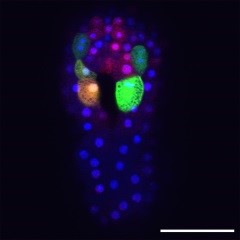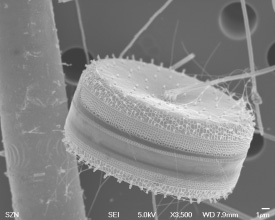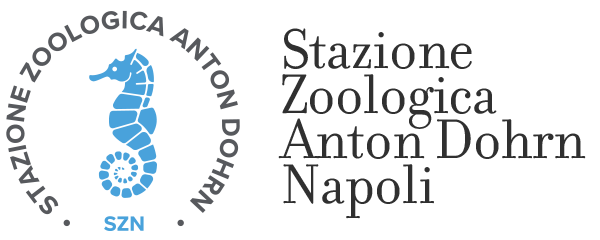Chair
Prof. Axel Meyer
Prof. Vincenzo Saggiomo
Alumni
Maria Grazia Mazzocchi
Marina Montresor
Maurizio Ribera d'Alcalà
Scipione Beatrice
Research Fellow
|
Aguzzi Jacopo Andrews Paul Bartoli Marco Boni Raffaele Caianiello Silvia Calò Antonio Cerrano Carlo Christiaen Lionel Crispi Stefania Donadio Carlo Faggio Caterina Feuda Roberto Fiorentino Fabio Giordano Daniela |
Iandolo Donata Iovino Nicola Mojetta Angelo Renato Rizzo Lucia Scipione Maria Beatrice Signorini Silvia Giorgia Swartz Zachary S. Taviani Marco Verde Cinzia
|
Updated on August, 2025

| Descrizione | L’Unità fornisce ai ricercatori tecniche aggiornate di microscopia ottica, elettronica, live cell imaging, microscopia confocale, microscopia 3D e 4D per la comprensione della struttura tridimensionale e i componenti subcellulari. |
| Servizi erogati |
- Assistenza tecnica agli utenti dei microscopi confocali - Assistenza tecnica agli utenti del microscopio a epifluorescenza corredato di sistemi di acquisizione di immagini - Consulenza per l’applicazione delle tecniche di microscopia ottica e confocale - Consulenza sull’analisi digitale delle immagini ottenute dalle osservazioni al microscopio - Formazione sull’uso delle attrezzature. |
| Attrezzature utilizzate |
- Microscopio Confocale Zeiss LSM 510 - Microscopio confocale Zeiss LSM 700 |
| Contatti |
Elio Biffali Tel. +39 081 5833 298 e-mail: elio.biffali(at)szn.it |
Department of Biology and Evolution of Marine Organisms
Director of Studies: Anna Palumbo
Project Summary/Abstract
The marine environment is characterized by a high biodiversity of species, which accounts for the enormous chemical diversity representing a great potential source of bioactive molecules. There is a great interest in exploiting the biological properties and biotechnological applications of marine compounds, as molecules with antioxidant activities. Among these, a new class of sulfur-containing amino acids, thiohistidine derivatives, termed ovothiols, was isolated and characterized from sea urchin eggs in the eighties at the Zoological Station. Recently, the enzyme responsible for the first step of its biosynthesis, 5-histidylcysteine sulfoxide synthase (Ovo), has been characterized. In silico studies have revealed the presence of homologous Ovo enzymes in more than 80 genomes, ranging from proteobacteria to animalia, suggesting a variety of roles played by this metabolite. Interestingly, ovothiol has been shown to be a promising pharmacological compound, being active on cancer cells and as neuroprotectant. The main objective of this study is to investigate, through a multidisciplinary approach, spanning from developmental biology to algal physiology, the biological activities of ovothiol in two different marine organisms inhabiting coastal seas, as the invertebrate sea urchin and microalgae from the diatoms’group.
The ability of diatoms, target species already studied and cultivated at the Zoological Station, to activate antioxidant activities expressing Ovo will be investigated in laboratory under different stress conditions and growth phases. In parallel, the involvement of this metabolite in stress response of the sea urchin Paracentrotus lividus will be examined exposing developing embryos to a series of chemical and physical stress agents and monitoring Ovo expression and ovothiol formation, using protocols already established in our group. Gene perturbation experiments will be performed on sea urchin and diatoms to assess the functional significance of ovothiol formation in both organisms.
Intellectual Merit
The proposed project will expand the knowledge about the biological properties of a marine natural product which can then drive future applicative studies. The expected impact will provide a better understanding of the ecophysiological functioning of coastal ecosystem submitted to environmental stresses, targeting both the pelagic and benthic systems.
Moreover, results obtained on the ovothiol production by diatoms are of huge interest in a biotechnological context, allowing to produce this molecule at low cost.
Broader Impacts
The study of the biological properties of ovothiols has the potential to impact other fields, e.g. nutraceutical. The antioxidant properties of this class of compounds might be exploited in the formulation of nutritional supplements.

| Descrizione |
L’unità AMOBIO fornisce un servizio di alta qualità per la preparazione di campioni per l’osservazione al microscopio elettronico a trasmissione (TEM) e scansione (SEM). Consulenza scientifica per l’applicazione delle tecniche di microscopia elettronica |
| Servizi erogati |
- Fissazione, disidratazione, inclusione in resina - Taglio sezioni semifini seriali - Taglio sezioni semifini e fini - Trattamento al Critical Point Drying per analisi al SEM) - Metallizzazione-Sputtering (per SEM) |
| Attrezzature utilizzate |
- Microscopio Elettronico a Trasmissione (TEM) ZEISS LEO 912 AB - Scarica il Manuale |
| Contatti |
Elio Biffali Tel. +39 081 5833 298 e-mail: elio.biffali(at)szn.it |
Department of Biology and Evolution of Marine Organisms
Director of Studies: Remo Sanges
Project Summary/Abstract
There is a battle going on in our genomes. This battle is present in an overwhelming portion of the tree of life. A transposable element (TE) is a genomic sequence that can duplicate itself in a different position within the genome. During a wave of transposition insertions, a specific TE invades a specific genome having a limited range of time to amplify itself until the assaulted genome evolve the epigenetic competence to silence it. This control is not always complete, some TE copies might retain limited activity to perpetuate their amplification. In this way they bypass their extinction as a consequence of the accumulation of mutations, but do not retain the potential to completely destroy the invaded genome. At this stage, TEs are defined "domesticated" and they should not be considered anymore mere barbarian parasites. A growing body of evidences suggests they should be better regarded as "symbionts". Indeed, although mutagenic, they provide fresh genomic matter that can be shaped by the host genome to evolve genetic novelties. The genomes of living organisms contain a high percentage of TEs. This can vary substantially among different species, but researchers are beginning to demonstrate that the more an organism is complex (it presents many different kind of cells), the higher is the percentage of such elements into the genome. Therefore, understanding the evolution of these elements would allow us to better understand how complexity evolved. We propose to develop specific bioinformatics pipelines to evaluate how these features of the genome are evolutionary related and how they shaped the eukaryotic genomes and complexity. This project departs from interesting outcomes recently gained in our research projects focusing around the sequencing of transcriptomes from diverse marine organisms and the development of related bioinformatics pipelines. Analyzing the genome and the transcriptome from many sequenced species, at different level of complexity, we aim at understand whether the expansion of TEs, in relation to the evolution of complexity, is a basic principle of biology. Finally, the better understanding of the evolution and the functional impact of these element is also important from a biotechnological perspective, indeed the unique characteristic of these elements, to specifically bind, edit and modify any genome, make them an attractive system for a vast repertoire of molecular applications.










